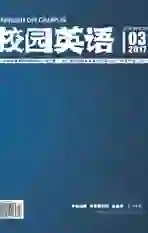Images in Classical Chinese Poetry
2017-03-15赵浩田
【Abstract】Most of Classical Chinese poems can be read as a commentary upon current events and society. Certain images and symbolism become quite conventional, and are the crux to understand many of the Classical Chinese poems. For example, the falling leaves in autumn can refer to personal or dynastic decline. The paper will take the film Life of Pi for example.
【Key words】Classical Chinese poems; Life of Pi
I. Symbols in Life of Pi
Has been deeply influenced by Chinese traditional culture, Ang Lees works are full of the metaphorical beauty of classical Chinese poetry. Appreciate a piece of poetry, which is aimed at the country and the people, for the most part, is covered by wind, flowers, snow, and moon. For example, Spring Comes to Jiangnan written by Du Mu:
(千里鶯啼绿映红)Red against green, and a huge troupe of warblers singing;
(水村山郭酒旗风)Hillside, riverside hamlets, with blue flags fluttering.
(南朝四百八十寺)The Southern Dynasties had four hundred eighty Building temples;
(多少楼台烟雨中)How many towers and terraces are wrapped in misty drizzles?
Maybe we can see a vivid and imaginary picture scroll of Jiangnan, but as a matter of fact, an array of temples exactly shows poets worry about the governor. Traditional narrative pattern always merciless on the surface, and soft inside. Ang Lee reforms this traditional method and replaces it by classical Chinese poetry. He makes full use of images to make the classical features prominent. Life of Pi is a movie, and also a piece of poetry.
First, Richard Parker is young Pi, the hyena represents the cook, the orangutan represents Pis mother, and the zebra is the Buddhist sailor. There are so many details and foreshadowing unifying the whole film and making it possess the beauty of zigzag and metaphor, the effects of “one word, three sighs” and “the tune lingered in the room” are shown fully. Second, lotus flower is another representative image. The first place the lotus flower appears is drawn by Pis mother, she combines it with Visnu——the God of Hindus. So later Pi sees his mother image in the water which turns from the lotus flower. The second place is after Pi growing up, meeting his first lover Anandi and there is a lotus flower in the forest in the dance. So later Pi found a tooth in the lotus flower on cannibal island. These two echoing are elaborate and the chaste lotus also makes the reality more cruel. Third, the lotus flower is one of religious musical apparatus of Visnu. Everyone knows about it that Visnu has become fish to save ordinary people, so the first fish Pi kills is the embodiment of Visnu, at least, he ascribes it to Visnu, and connect to the second story which the adult Pi tells us, the fish is the people. Fourth, Visnu is told by Pi mother and it implies that Pi will be surviving by eating his mother: the shape of the island like a woman, the rootstock is an image of his mother, the meerkats on the island represent decay, the lake in the center of the island can be regarded as gastric acid and the meaning of the tooth is surely clear. Among these beautiful things, we feel nearly cold and horrible, as the same as we feel angry after reading Spring Comes to Jiangnan. Maybe the effect of images in classical Chinese poetry you will not know if I dont say, that is because they are so perfect no less than the nature itself.
II. A Visual Treat
What astonishes me is how much I love the use of 3-D in Life of Pi. Ive never seen the medium better employed, and although I continue to have doubts about it in general, Lee never uses it for surprises or sensations, but only to deepen the films sense of places and events. The whole movie is a dream, and its so unique and beautiful no fewer than Avatar. People say its a Chinese Ink and wash painting. Yes, it is. Just as classical Chinese poetry, this is also a piece of monochrome abbreviated ink work. The most important thing in classical Chinese art is the essence of objects, the spirit and emotion conveyed by artists. The objective fact seems to be unimportant, this is an art about subjectivity. What is called “scrambled in appearance but united in spirit”. Shape is not alike, but resemblance in spirit. Just because this unusual visual style, we find ourselves in an entirely new world, along with the special effects of light.
III. Conclusion
Many Classical Chinese poems appear simple on the surface, but contain deeper, more profound ideas. In order to realize what these are, readers are expected to meet the poet on the way—not just to be told something, but to actively think and feel in sympathy with the poet or the poets characters. And its really the sensual pleasure to enjoy Life of Pi as enjoying classic Chinese poetry.
References:
[1]Spence,Jonathan D,2004,The Chans Great Continent:China in Western Minds.[M]N.Y.:Penguin Books Ltd.
作者簡介:赵浩田(1993-),女,山西运城人,研究方向:英语语言文学专业。
